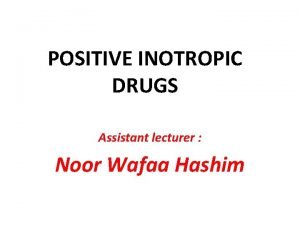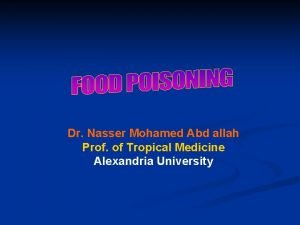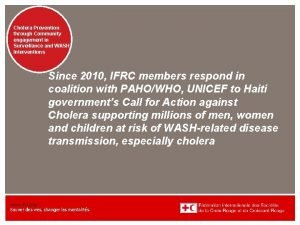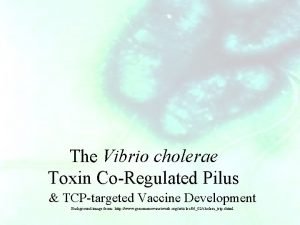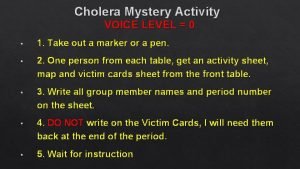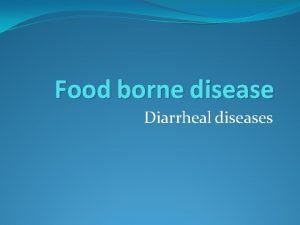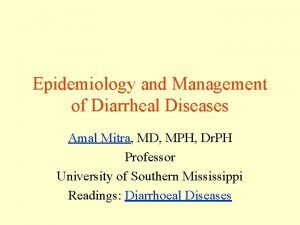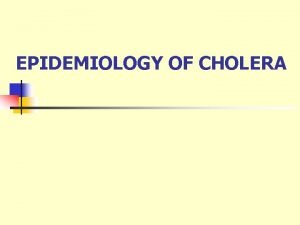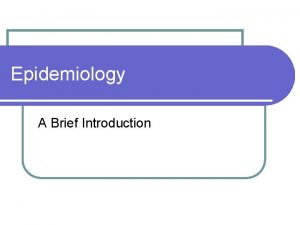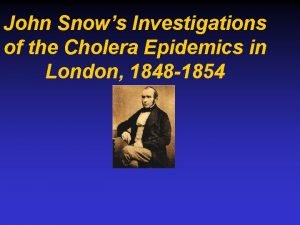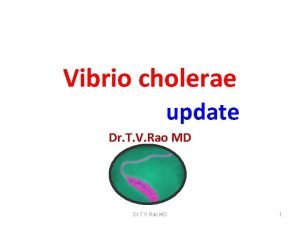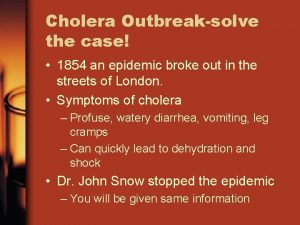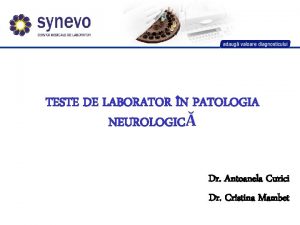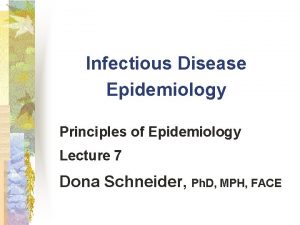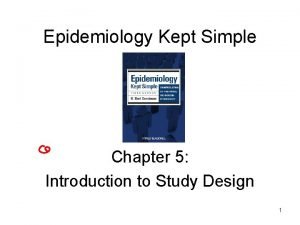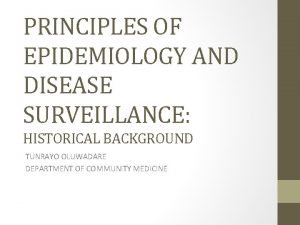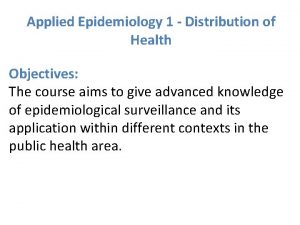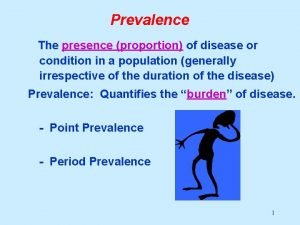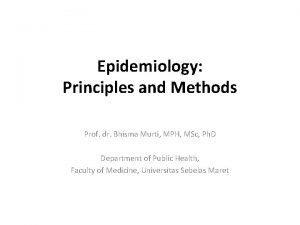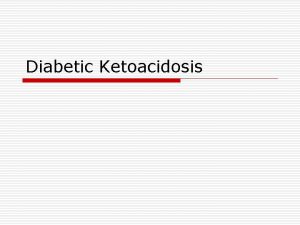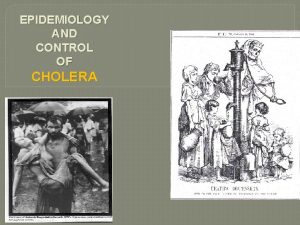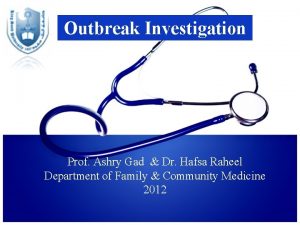Epidemiology of Cholera Ashry Gad Mohamed Professor of













































- Slides: 45

Epidemiology of Cholera Ashry Gad Mohamed Professor of Epidemiology College of Medicine & KKUH

• Greek word for the gutter of a roof, comparing the deluge of water following a rainstorm to that of the anus of an infected person

• Acute intestinal infection caused by the bacterium Vibrio cholerae characterized by: • profuse watery diarrhoea with flecks of mucous material (rice water stools), vomiting, abdominal pain • Rapid onset of dehydration causing severe weakness, poor skin turgor, sunken eyes and cheeks

• Often muscular cramps, cyanosis, subnormal temperature, tachy-cardia, hypotension; renal failure may follow inadequate treatment • Without treatment a healthy person may become hypotensive within one hour & may die within 2 -3 hours. • More commonly: from 1 st liquid stool to shock 4 -12 hours.

Mechanism • Entrotoxin activates adenylate cyclase enzyme in intestinal wall that is converted into pump that extract water & electrolytes from blood and tissues to intestinal lumen with shedding of mucous and epithelial cells giving rice water severe diarrhea

Infectious agent: Vibrio cholerae • epidemic cholera is caused by two biotypes of Vibrio cholerae : – the classical biotype serogroup O 1, and – since 1961 (7 th pandemic), the biotype El Tor • Serogroup O 1 includes serotypes Inaba, Ogawa and Hikojima • Serogroup O 139: in 1992/93, a new Vibrio cholerae O 139 strain appeared

• Vibrios are one of the most common organisms in surface waters of the world. They occur in both marine & fresh water habitats and in association with aquatic animals.

• Most infections are subclinical cases, but excrete the organism in faeces for 7 -14 days. • Only 10% of the infected persons develop typical cholera. • 90% of episodes are mild or moderate. • Case fatality without treatment = 25 -50%. • Case fatality with treatment (ORS) = 1%

• During the 19 th century, the classical biotype of V. cholerae serogroup O 1 caused pandemic cholera, spreading from India to most of the world; currently confined to the Indian subcontinent • Since 1961, the biotype El Tor of V. cholerae serogroup O 1 has spread through Asia into Africa, Europe (small epidemics), and South America (since 1991): 7 th cholera pandemic • V. cholera serogroup O 139 was mainly isolated in Asia and represents currently 15% of isolates

• During 2000, 56 countries have officially reported 137 000 cases and 4 900 deaths; however, >150 000 deaths/year are estimated in developing countries, about one third in children <5 years

Current epidemic 7 th epidemic • Due to V cholerae 01, V eltor & V cholerae 0139 • Started 1961 in Indonesia. • Bangladesh 1963 • India 1964 • West Africa 1970 • Latin America 1991 • Bangladesh 1992 (V cholerae 0139) • South East Asia • South Africa 2000



Selected morbidity indicators • • • Cholera Malaria Poliomyelitis Measles Pulmonary tuberculosis Diphtheria 7 Tetanus 32 Neonatal tetanus 22 AIDS 63 Meningococcal meningitis 12 1059 0 373 2192 18 2005 2005 2005

• Incubation period: 1 -5 days. • Modes of transmission: 1 -Contaminated water and food. 2 -Rarely direct from person to person. • Reservior 1 -Aquatic environment (Brackish water & sea food) 2 -Human beings

• Communicability (stool-positive stage): Usually ends few days after recovery, occasionally several months carrier state, antibiotics can shorten the period of communicability

Prevention and control • • • - Hygienic disposal of human faeces. Adequate supply of safe drinking water. Good food hygiene Cooking food thoroughly & eating it hot. prevent contact of cooked food with raw contaminated food, water or ice. - Avoid raw vegetables unless peeled Boil it, cook it, peel it or forget it. - Mass chemoprophylaxis has no effect

Vaccination: o The previous parenteral cholera vaccines had little efficacy and are not recommended for use in endemic areas, during outbreaks, or in people traveling to endemic areas. o Oral immunization: (1) killed bacterial vaccines (2) live genetically engineered mutants deleted of toxin genes (3) avirulent vectors genetically engineered to express protective cholera antigens.

Oral killed vaccines an oral vaccine containing killed V cholerae O 1. • successful immunity for 6 months, which later waned. • Unfortunately, in patients who need the vaccine most (children), the immunity was poor. • Need multiple dosages. • This vaccine is now disrepute

Oral live vaccines • Appears to be safe and induces protective immunity as soon as 8 days after immunization, even after a single dose in adults. • It is effective in children and healthy volunteers. • Confer 80% immunity against El Tor cholera. However, its efficacy in endemic and non-endemic areas and across all populations is yet to be established.

For a vaccine to be useful in endemic areas, it should do the following: – Produce long-lasting immunity – Be compatible with the Expanded Program on Immunization – Be able to produce immunity rapidly, ideally after one dose, to be useful in epidemics - Protect against El Tor O 1 and O 139 Bengal strains

• Because the secondary attack rate of cholera in the household is high, selective antimicrobial prophylaxis of contacts has been attempted. This is not feasible as a routine public health measure.

• Food products from cholera infected regions: - Vibrio cholerae 01 survives 5 days in ambient temperature & 10 days at 5 -10 degrees. -It survives freezing & low temperature. -It is sensitive to acidity & drying. -It is sensitive to Gamma irradiation & temperature above 70 degrees.

Epidemiology of Typhoid fever

• An acute infection with prolonged fever due to Salmonella typhi sometimes lead to severe complications. • Globally 16 million cases with 600000 deaths annually. • Salmonella paratyphi A & B lead to milder disease. • S. t. / S. p = 10 – 1 • Peak age 4 -19 years.

• Disease caused by S. typhi is typhoid fever. • In past, many deaths were due to typhoid fever worldwide. Now mostly • localized to developing countries. • People not only become ill and die but can become colonized by S. typhi resulting in being carriers and spread typhoid fever.

• Incubation period for S. typhi is a week to a month post-ingestion. • Bacteria multiply in liver and spleen then released systemically • (blood). Results in high fever, chills, anorexia.

Poorer Countries are Vulnerable • Typhoid Fever seems to matriculate in places with poor sanitary conditions. • Places where water is not sanitized provides the perfect environment for Typhoid Fever.

Typhoid Fever Ingest S. typhi Bacteria invades intestinal cells and translocates to systemic organs Multiplies to high number in liver and spleen Spreads to bloodstream Bacteria move to gallbladder Shed in Bile Bacteria persists in gallbladder DEATH Bacteria shed in feces TYPHOID





Risky groups • Children and young adults in endemic areas. • Contacts of chronic carriers. • Microbiology technicians. • Food handlers. • Travelers and military personnel

Incubation period: • 10 -14 days. Modes of transmission: • Water contaminated with fecal materials. • Contaminated food. • Food handlers. Reservoir: Only human (cases & carriers)

Typhoid carriers • About 1– 5% of people who are infected with S. typhi become asymptomatic chronic carriers. • The carrier state may follow acute or mild illness or subclinical infection. • The incidence of chronic carriage is higher among women and persons with biliary tract abnormalities. • Antibiotic use and antibiotic resistance may also affect the propensity to become a chronic carrier. • A chronic urinary carrier state occurs in individuals with schistosome infection. • Carriers who handle food without observing proper hygiene can transmit infection to others.

Transmission • Typhoid is spread by the faecal-oral route. Occasionally transmission may be direct, but usually it occurs following the ingestion of contaminated water or food. • In developing countries with contaminated water supplies and primitive sewage disposal systems, water is the most likely vehicle of transmission.

Epidemics originating from water contamination are particularly explosive. because • a water source may serve a large population. • Water dilutes gastric acid which would otherwise inactivate pathogenic agents. • Water and other beverages remain in the stomach only very briefly

• In more developed countries, with good sanitation, typhoid transmission is more likely to be associated with food contamination by an undetected carrier or a breakdown in proper practices of personal and food hygiene.

Communicability • Typhoid is communicable as long as S. typhi organisms are excreted, usually from the first week and throughout convalescence. • About 10% of untreated typhoid fever patients will excrete bacteria for 3 month after onset of symptoms.

Prevention and control • Basic sanitary and hygienic measures Purifying water supplies. Improving water delivery and sewage control. Construction and use of latrines. Boiling water Supervision of foodhanders.

Vaccines • Three vaccines to typhoid fever: 1. Killed whole bacteria with side effects. 2. Capsular material (Vi antigen) that is safer and more effective. 3. Live oral vaccine, attenuated S. typhi strain (Ty 21 a). Oral vaccines are still being developed to distribute in developing countries. Ty 21 a is also being used to carry foreign antigens from Shigella and V. cholerae.

Number Time of doses between necessar doses y Total time Minimum needed age for to set vaccinati aside for on vaccinati on Booster needed every. . . Vaccine Name How given Ty 21 a (Vivotif Berna, Swiss Serum and Vaccine Institute) ------ 1 capsule by mouth 4 2 days 2 weeks 6 years 5 years Vi. CPS (Typhim Vi, Pasteur Merieux) Injection 1 N/A 2 weeks 2 years

• Indication of vaccination: Travellers to endemic areas. People in refugee camps. Microbiologists. • Treatment: Antibiotics : Ciprofloxacin, pefloxacin & cephalosporins

 Dr ashry
Dr ashry How dr. wafaa elsadr epidemiology professor
How dr. wafaa elsadr epidemiology professor How dr. wafaa elsadr epidemiology professor
How dr. wafaa elsadr epidemiology professor Professor nasser mohamed
Professor nasser mohamed Promotion from assistant to associate professor
Promotion from assistant to associate professor Cholera
Cholera Cholera
Cholera Toxin coregulated pilus
Toxin coregulated pilus Voice level 0
Voice level 0 Cholera 1817
Cholera 1817 Diarrhea treatment plan a b c
Diarrhea treatment plan a b c Types of cholera
Types of cholera Cholera outbreak malaysia
Cholera outbreak malaysia Cholera is a greek word that means gutter of roof
Cholera is a greek word that means gutter of roof Cholera toxin
Cholera toxin Cholera
Cholera Cholera
Cholera Stool analysis
Stool analysis Cholera
Cholera Gad accounting
Gad accounting Gad levanon
Gad levanon Wid wad gad
Wid wad gad Gad goals
Gad goals Amy drahota
Amy drahota Benchmakr
Benchmakr Gender sensitivity training topics
Gender sensitivity training topics Hydroxyzine vs xanax
Hydroxyzine vs xanax Gad-7 scoring
Gad-7 scoring Budgetü
Budgetü Anticorpi vgkc
Anticorpi vgkc Similarities between wid and wad
Similarities between wid and wad Incidence and prevalence meaning
Incidence and prevalence meaning Logistic regression epidemiology
Logistic regression epidemiology Attack rate
Attack rate Epidemiology kept simple
Epidemiology kept simple Ramboman
Ramboman Defination of epidemiology
Defination of epidemiology Difference between descriptive and analytic epidemiology
Difference between descriptive and analytic epidemiology Celiac beri beri
Celiac beri beri Distribution in epidemiology
Distribution in epidemiology Prevalensi adalah
Prevalensi adalah Define epidemiology
Define epidemiology Pros and cons of cross sectional study
Pros and cons of cross sectional study How to calculate prevalence
How to calculate prevalence Epidemiology definition
Epidemiology definition Diabetic ketoacidosis epidemiology
Diabetic ketoacidosis epidemiology


